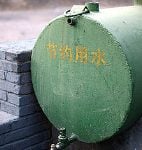Economically developed areas of China have long suffered from water shortages, particularly from a scarcity of clean water, and the situation is only getting worse.
In an average year China has 2,800 billion cubic metres of water available for use, 40 billion cubic metres less than what is needed for continued economic growth. And it is unevenly distributed. Rivers are drying up intermittently in some cases, permanently in others.
The biggest problem is water pollution and the degradation of ecosystems. These are causing shortages as increasing levels of effluent are discharged by industry, combined with the overuse of pesticides and fertilisers in agriculture. One half of Chinese lakes tested suffer from eutrophication. Drinking water for 200 million to 300 million people fails to meet quality standards.
A plan for managing water resources is needed, but what form it will take is unclear. A set of new management regulations, published by Guandong province, for the Dong River, Xi River, Bei River and Han River basins provides a good example of how to proceed. There are deeper issues, however, that will need to be addressed – and not only in that province.
Guangdong enjoys substantial rainfall; historically, it did not suffer from water shortages. But economic development has brought a scarcity of clean water. Around one-quarter of its rivers – 1,754 kilometres of 7,051 kilometres – fail to meet Class III water quality standards. Only 21 of 41 sources of urban drinking water are up to standard. The Dong River basin is home to 30 million people and generates 2.3 trillion yuan (US$337 billion) in GDP (total GDP for the province last year was almost 3.6 trillion yuan). The Dong River has suffered from droughts in recent years, with river water levels falling, water quality worsening, salt water flowing upstream and algae blooming in some reservoirs.
The new regulations call for improvements in allocating water resources, controlling water use and licensing water extraction. They also call for ecological compensation payments as part of the water management system. One proposal fixes the maximum amount of water to be extracted from the river annually at 1.0664 billion cubic metres and divides this up between eight cities. This shifts the need to conserve water to city governments, businesses and residents. Once water rights have been confirmed, cities such as Heyuan can sell water, earning an income to offset the ecological damage caused by transferring industry from the Pearl River Delta to surrounding areas. However, these well-intentioned policies throw up problems that should not be ignored.
First, the legal environment is not in place that would allow ecological compensation to have anything more than limited effect. A framework is needed to establish who pays compensation to whom, the amount to be paid and how. A central question is whether these funds are to be paid to local government or to residents. How should the owners of ecological resources be identified? Ecological compensation is a means of dealing with externalities and balancing regions and delivering social justice: payments should go from those who benefit from the use of resources to those who suffer; from developed areas to undeveloped areas; from the rich who consume a lot to the poor who consume less. For example, 30% of the price of entry tickets for Chengshan Scenic Area, Sichuan province, is used to compensate locals, ensuring that the area is protected.
However, the fact that compensation in water rights reform is orientated toward government means that the money may not reach the right pockets. Until the system for evaluating official performance, which is currently framed in economic terms, is reformed, the environment will continue to suffer for the sake of economic growth. Many upstream cities have made economic sacrifices for the sake of protecting water resources, but recent years have seen development in poorer cities, such as Qingyuan, Gengxi, Heping, Dongyuan, Zijin and Lianping. This brings with it industry, deforestation and mining, and many environmental challenges.
The government is looking at compensation payments for upstream cities to improve their environments, paid for by richer downstream cities. But once the upstream cities have the cash in hand, will they actually slow economic growth and put the environment first? Not necessarily. Weak enforcement and the primacy of economic growth are the issues at stake, not inadequate compensation. The root of environmental destruction is found in the evaluation of political performance. Compensation without institutional reform will not solve the problem: the economy will still come first.
Moreover, competing interests can distort the way that compensation works. Hydropower producers, for instance, argue that farmers benefit from less soil erosion; others argue that tourism benefits from an improved environment; or shipping can benefit from improved river flows. Should these industries pay compensation? At the same time, governments that receive compensation may not use it for environmental protection. There have been cases of local governments demanding environmental compensation from different departments: forestry, water resources, agriculture, poverty reduction and so on. Money can end up being spent on nothing more than new government offices. The United States saw several disputes over water rights payments in the 1990s. The potential for similar conflicts in Guangdong should not be ignored.
Before environmental compensation can play a role in the allocation of water rights, systems of environmental regulation will need to be improved, not only in Guangdong, but also across the country. This should include a complete reform of the political evaluation of officials; reorganising the relationships between different departments; clarifying resources rights and protection all the way to the individual level; and more open participation and oversight. With these reforms in place, water rights can be allocated and traded by government and markets.
Tang Hao is a Guangzhou-based academic and commentator.
Homepage photo by Changhua Coast Conservation Action



